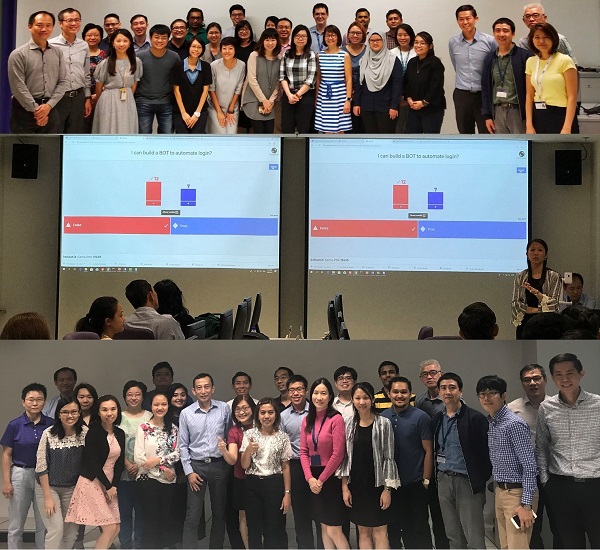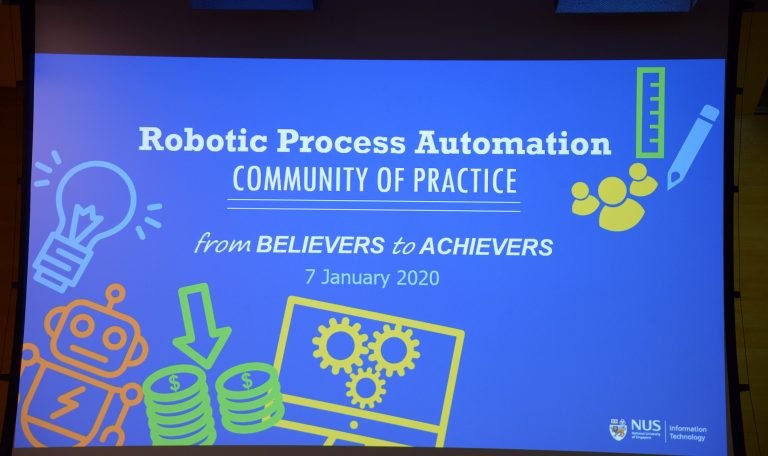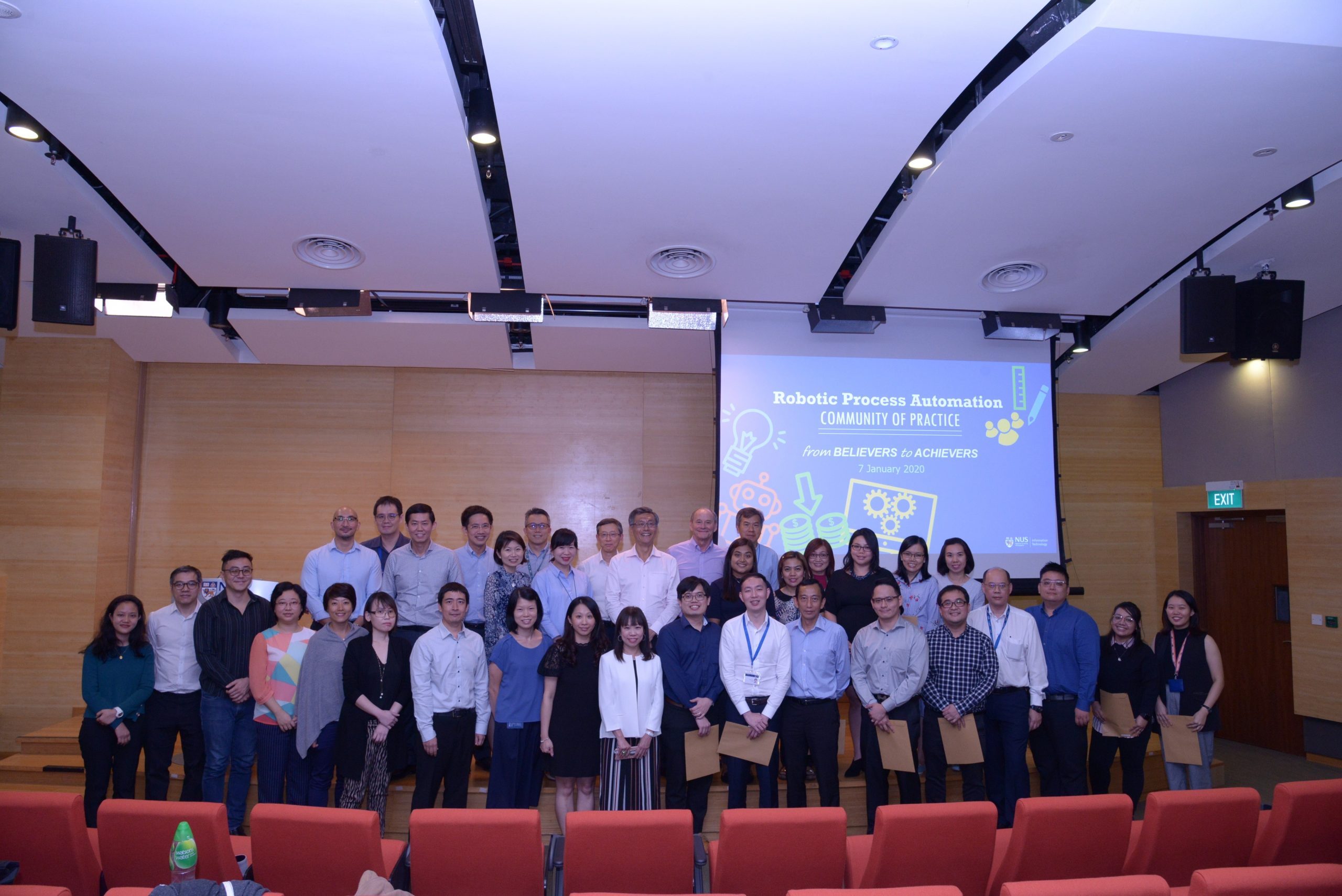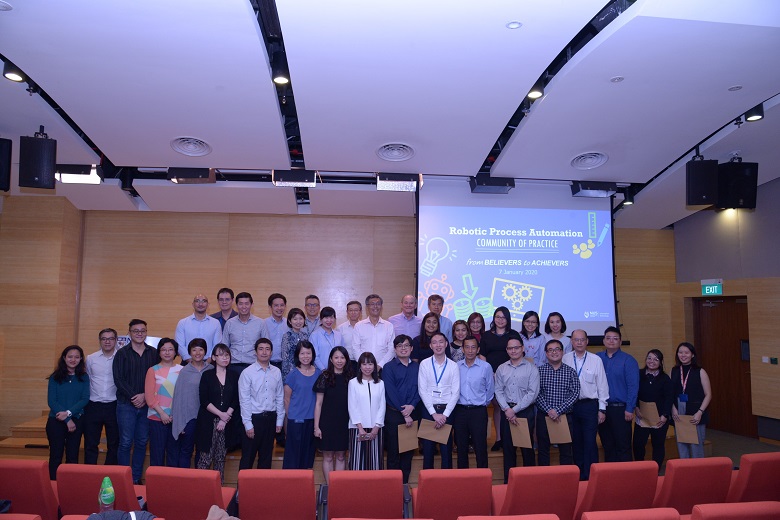NUS RPA Enablement
9 March 2020
By Jay Wee
Before computers became an essential part of the workforce, everything was done on, yes, you have it, papers.
All types of records from files and financial numbers, to documents and manuals, were in the form of paper, and this meant manual processes for a host of day-to-day tasks.
Just picture someone – unusually large spectacle frame, 80’s hairdo, sitting behind a desk, and on it are these:

When they look up, all they see are piles and towers of papers and documents.
And that was how things were done, before the digital age.
Enter The Digital Age and RPA
Now, we still perform all those tasks manually, but just from our computers. Copying data, reading those forms and selecting the correct entry from the mountain of submissions are still a part of our daily processes. We no longer get piles and towers of papers stacked on our desk, but instead get pinged by that voice “You’ve got mail!” a few hundred times. The mountains of papers are just stored digitally inside a hard disk – no longer tangible and no longer in ring binders.
And we ask ourselves – Isn’t the digital age supposed to bring vast improvements where we each get our own robot butler or assistant to do those things for us? Why are we still clicking on the mouse doing these repetitive manual processes, where a single wrong selection or entry can cause the entire process to fail? Aren’t we humans supposed to do more creative and analytical work?

Fret not! Out there, a type of robot does exist (NOT the one you see above here) and once you set it up properly, it will be able to perform these tedious, repetitive and gruesome manual processing tasks, lightning fast and free from errors too!
No, it isn’t an actual physical robot as that would cost WAY too much. The Robotic Process Automation (RPA) is the software answer to the problem stated. It simulates how an actual human would interact with a computer. It can be simulating the mouse click, typing the texts, starting an application and doing much more. The computer will not be able to distinguish differentiate inputs from the RPA application and from a human in that regard.
This presents an opportunity to solve many other problems, present and future. As times move forward and things get more complicated, we can no longer afford to spend time on dull and mundane tasks.
We need to do better.

Enablement Program
Back in August 2019, NUS started a digital enablement programme where a segment of it focuses on equipping our NUS administration staff with the tools, knowledge and skills to harness the benefits of RPA. The response was very positive as both classes were oversubscribed!
40 staff were lucky enough to be selected for this inaugural programme.

NUS, with its history, size and population, houses many departments and inevitably, would have created many day-to-day administrative processes be they in Finance, Human Resource, IT security or Procurement related.
Now comes the next challenge: should we use RPA for ALL the existing processes? If not, which ones should we choose and which is worth our investment? There are many factors to consider before embarking on the bot creation to replace the manual process.
To start with, the enablement programme armed our staff with the necessary equipment and skills to identify areas in their work where RPA can be implemented effectively.
After the course, these RPA practitioners would first work with the NUS RPA team, focusing on creating their own bot that could tackle the process on their end.
If compatible, they could even share it with other colleagues who have similar processes.
Upon successful implementation of their bots, our practitioners would then be attached to a “shared service” programme where they get to assist new practitioners of RPA developing their bots. This Community of Practice (COP) platform was set up so that practitioners can share their knowledge and experiences with each other.
Challenges
Too technical
Every implementation has its pros and cons. One of the main challenge with this implementation in NUS is the need for the practitioners to have some technical knowledge in order to understand the jargons and concepts presented to them.

In some cases, there might be a need for scripting / programming to get the bots to do what is required. Therefore, staff with no programming background will also have to pick up the skills and concept from scratch.
Not always the best for all problem statements
Over the course of implementation, some departments realised that RPA might not always be the best solution for a particular task. External applications like Excel Macros, VBA Scripts and even Splunk were introduced to overcome that hurdle. This created further complications to the administrative staff who have no relevant experience.
Not feasible for all processes
As mentioned above, not all processes can be made better with RPA to run them. Staff have to be able to identify those that can maximise the effectiveness and efficiency if RPA is applied (scalability, complexity and duration etc). The staff will have to justify and make sure that a bot is worth creating.
Process changes also poses a threat to RPA as a minor deviation in the way things are done could mean a revamp and creation of a totally different bots.
Fear of being replaced
One of the most common concerns was that RPA practitioners are afraid of getting replaced by the bots. The implementation team have to explain that the main focus is to automate process and improve productivity, not to replace a human who is able to perform a more analytical task that requires complex decision making skills.
Community of Practice
With that and the success of the RPA enablement programme, staff who attended the course graduated. Transforming from Believers to Achievers; amateurs to advocates, they are now equipped to harness technology to bring efficiency to their day-to-day processes.

This was celebrated at a RPA COP event, where the spotlight was shone on those graduated staff. The event saw the privilege of NUS President Prof Tan Eng Chye, DPAF Mr John Wilton, CITO Tommy Hor and Deputy CITO, Ms Tan Shui-Min, who graced the occasion to hear colleagues share their success stories, knowledge and experience. This event also established the COP as the official avenue that encourages RPA learning and support amongst a network of experienced practitioners.

Close to 100 RPA bots have been created since the programme started, and a whopping 12,000 hours has been estimated to be saved by using these RPA bots that eliminate the tedious effort in their daily work!
NUS IT will continue to support this digital enablement programme after this first successful run, and ride on this success to inspire more staff to take up the challenge moving forward.
Why is RPA still worth considering?
Of course there are alternatives to RPA. A department can always outsource those mundane processes and task to a temp, intern or new hire. But those comes with their own set of issues as well (leave, cost, sickness etc). An RPA bot is not so susceptible to those issues.
Scalability is also another factor when it comes down to alternative. A bot can be replicated easily throughout the whole campus but an intern can only be at one place at a time.
There is also the issue of staff resignation or leaving the department where additional time and cost is needed to re-train or find a replacement. That goes without saying, all those challenges stated above with having a human performing repetitive task comes in as well (human errors and slower speed).
All these just makes it seems like RPA is the better solution overall at this point in time.
Conclusion
The RPA industry is definitely a force not to be taken lightly in the future, with Gartner stating that approximately $680 million has been spent on RPA in 2018 and Forrester forecasting that the industry will be worth $12 billion by the year 2023.
With the world-wide adoption trend being extremely positive and with NUS IT’s interest of being at the forefront of technological advances, we can definitely work together towards integrating RPA to play a bigger part, and not just in administrative roles in the future.


